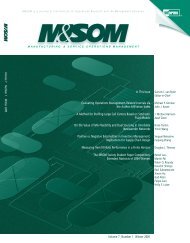Strengthening the Empirical Base of Operations Management
Strengthening the Empirical Base of Operations Management
Strengthening the Empirical Base of Operations Management
You also want an ePaper? Increase the reach of your titles
YUMPU automatically turns print PDFs into web optimized ePapers that Google loves.
Fisher: <strong>Streng<strong>the</strong>ning</strong> <strong>the</strong> <strong>Empirical</strong> <strong>Base</strong> <strong>of</strong> <strong>Operations</strong> <strong>Management</strong><br />
374 Manufacturing & Service <strong>Operations</strong> <strong>Management</strong> 9(4), pp. 368–382, © 2007 INFORMS<br />
would be more effective than an expert system.<br />
Clearly, <strong>the</strong> work at Westinghouse has structured <strong>the</strong><br />
problem to <strong>the</strong> point where one can visualize applying<br />
ideas like those in Ross (1971). Forexample, it is<br />
tempting to think <strong>of</strong> <strong>the</strong> 350 identified failure conditions<br />
as states in a Markov process and <strong>the</strong> actions<br />
available to <strong>the</strong> expert as <strong>the</strong> actions in Ross’s model.<br />
However, <strong>the</strong> scale <strong>of</strong> real problems is several orders<br />
<strong>of</strong> magnitude bigger than <strong>the</strong> problems addressed in<br />
<strong>the</strong> literature, so computational tractability could be a<br />
majorchallenge.<br />
5. Principles<br />
Prescriptions derived from empirical research can be<br />
numeric and detailed, such as <strong>the</strong> output <strong>of</strong> an algorithm,<br />
or more qualitative principles that provide general<br />
guidance but require some interpretation on <strong>the</strong><br />
part <strong>of</strong> <strong>the</strong> user. Perhaps <strong>the</strong> best example <strong>of</strong> prescriptive<br />
principles is <strong>the</strong> Toyota Production System, which<br />
provides guidance on how to structure a production<br />
process and manage workers to achieve a high level<br />
<strong>of</strong> quality and productivity.<br />
My favorite example <strong>of</strong> principles reported in <strong>the</strong><br />
academic literature is <strong>the</strong> study by Jordan and Graves<br />
(1995), which describes several principles <strong>of</strong> manufacturing<br />
flexibility derived from empirical research<br />
within <strong>the</strong> auto industry. They consider a company<br />
that makes N products with uncertain demand in M<br />
factories with fixed capacity. Because <strong>of</strong> <strong>the</strong> limited<br />
capacity, it may not be possible to satisfy fully a particulardemand<br />
realization. The amount <strong>of</strong> demand<br />
that is satisfied can be increased by providing <strong>the</strong><br />
flexibility to make a particular product in more than<br />
one plant. In <strong>the</strong> extreme, when every product can<br />
be made in all plants, demand can be fully satisfied<br />
as long as total demand for<strong>the</strong> N products does<br />
not exceed <strong>the</strong> total capacity <strong>of</strong> <strong>the</strong> M plants. However,<br />
providing this maximal level <strong>of</strong> flexibility is usually<br />
prohibitively expensive, so Jordan and Graves<br />
(1995) ask how closely more limited flexibility would<br />
come to achieving <strong>the</strong> demand satisfaction benefits<br />
<strong>of</strong> full flexibility. Starting with this natural question<br />
and drawing on insights gleaned from extensive interaction<br />
with General Motors managers, <strong>the</strong>y derive<br />
several principles <strong>of</strong> flexibility and provide analytic<br />
support for <strong>the</strong>se principles.<br />
Their sharpest result is stated as a property <strong>of</strong> <strong>the</strong><br />
product-plant assignment graph, which has a node<br />
foreach product and foreach plant and an arc connecting<br />
product node i with plant node j if product i<br />
can be made in plant j. They show that when M = N ,<br />
<strong>the</strong> ability to make each product in just two plants<br />
provides nearly <strong>the</strong> same level <strong>of</strong> demand satisfaction<br />
as full flexibility, provided <strong>the</strong> product-plant assignment<br />
graph is connected.<br />
6. Integrating Theory and Empirics<br />
As discussed at <strong>the</strong> start <strong>of</strong> this paper, medicine,<br />
physics, and finance have benefited from a healthy<br />
synergy between <strong>the</strong>oretical and empirical research.<br />
Theoreticians develop hypo<strong>the</strong>ses that are verified<br />
by empiricists, and empiricists identify interesting<br />
phenomena in <strong>the</strong> world to be explained through<br />
additional <strong>the</strong>ories. Some examples <strong>of</strong> research that<br />
integrates <strong>the</strong>ory and empiricism are beginning to<br />
emerge in our field.<br />
One such example focuses on a betterunderstanding<br />
<strong>of</strong> <strong>the</strong> relationship among <strong>the</strong> four traditional<br />
performance measures in operations management:<br />
cost, manufacturing conformance quality, delivery<br />
speed, and flexibility. Traditionally, <strong>the</strong>se measures<br />
have been thought to trade <strong>of</strong>f against each o<strong>the</strong>r.<br />
For example, improving quality meant increasing cost<br />
(we will use cost and quality as ourexamples in<br />
<strong>the</strong> rest <strong>of</strong> this section, although it should be clear<br />
that <strong>the</strong> concept is also applicable to <strong>the</strong> o<strong>the</strong>rperformance<br />
measures). More recently, Clark (1996) and<br />
Hayes and Pisano (1996) have suggested that companies<br />
can and do follow improvement paths that simultaneously<br />
increase quality and reduce cost.<br />
A little thought makes it clearthat a company<br />
can take various actions to improve quality; some <strong>of</strong><br />
those actions will increase cost and some will reduce<br />
cost. To illustrate, consider a process that produces<br />
a product with a 10% defect rate. An inspector at<br />
<strong>the</strong> end <strong>of</strong> <strong>the</strong> process attempts to cull out defective<br />
units to be reworked or scrapped. But because<br />
inspection is imperfect, <strong>the</strong> inspector only catches half<br />
<strong>the</strong> defects, resulting in a 5% defect rate reaching<br />
<strong>the</strong> market. Adding a second inspector who independently<br />
detects half <strong>the</strong> remaining defects would<br />
reduce <strong>the</strong> defect rate to 2.5% but would increase cost<br />
because <strong>of</strong> <strong>the</strong> expense <strong>of</strong> <strong>the</strong> additional inspector,




